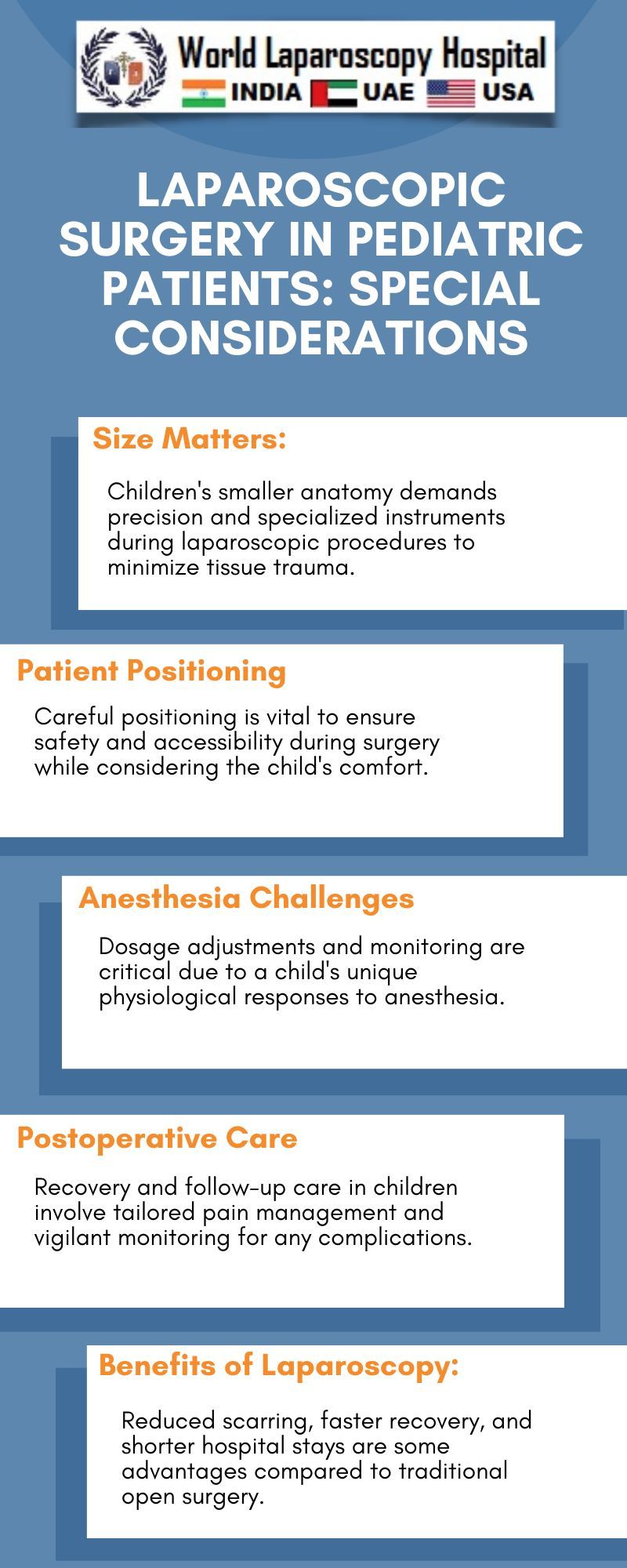Laparoscopic Surgery in Pediatric Patients: Special Considerations
Laparoscopic Surgery in Pediatric Patients: Special Considerations
Introduction:
Laparoscopic surgery has revolutionized the field of pediatric surgery, offering numerous advantages over traditional open procedures. The minimally invasive nature of laparoscopy minimizes trauma, reduces postoperative pain, and accelerates recovery. However, performing laparoscopic surgery in pediatric patients entails unique challenges and considerations owing to their distinct anatomical, physiological, and developmental characteristics.

Anatomical Considerations:
Size Matters:
Pediatric patients, ranging from neonates to adolescents, present a spectrum of sizes. Surgeons must adapt instruments and trocar sizes to accommodate the smaller abdominal cavities of children, ensuring precision while avoiding injury to surrounding structures.
Organ Development and Positioning:
The ongoing development of organs in pediatric patients necessitates careful consideration of their positioning during laparoscopic procedures. An understanding of the dynamic nature of pediatric anatomy is critical to avoid inadvertent injury and ensure optimal outcomes.
Physiological Considerations:
Hemodynamic Variability:
Children exhibit greater hemodynamic variability compared to adults. Surgeons must closely monitor vital signs and adapt anesthetic management and fluid administration to account for these fluctuations, ensuring hemodynamic stability throughout the procedure.
Carbon Dioxide Insufflation:
Maintaining a clear surgical field through carbon dioxide insufflation is crucial in laparoscopic surgery. Pediatric patients may be more sensitive to changes in CO2 levels, making careful monitoring essential to prevent adverse effects such as hypercarbia and acidosis.
Developmental Considerations:
Age-Specific Challenges:
The age of the pediatric patient introduces unique challenges. Neonates may have underdeveloped abdominal walls, while older children may have thinner abdominal walls, requiring meticulous trocar placement to avoid complications such as bowel or vessel injury.
Cognitive and Emotional Impact:
Consideration must be given to the cognitive and emotional impact of surgery on pediatric patients. Tailoring communication to the child's developmental stage, involving parents in the preoperative process, and providing age-appropriate information can help alleviate anxiety and facilitate a smoother surgical experience.
Technical Considerations:
Instrumentation and Trocar Placement:
The selection of appropriately sized instruments and meticulous trocar placement are critical aspects of pediatric laparoscopic surgery. Surgeons must navigate the limited space within the child's abdominal cavity, emphasizing precision and avoiding instrument crowding.
Visualizing the Surgical Field:
Achieving optimal visualization is paramount in laparoscopic surgery. Pediatric patients may have smaller spaces between organs, requiring innovative techniques such as the use of smaller cameras and angled scopes to enhance visibility and facilitate successful procedures.
Benefits and Outcomes:
Reduced Postoperative Pain:
One of the primary advantages of laparoscopic surgery in pediatric patients is the reduction in postoperative pain. This benefit contributes to quicker recovery times and improved overall patient satisfaction.
Faster Recovery and Shorter Hospital Stays:
Minimally invasive techniques often result in shorter hospital stays and faster recovery, allowing pediatric patients to resume normal activities sooner and reducing the burden on healthcare resources.
Case Studies and Success Stories:
Appendectomy in Pediatric Patients:
Explore a case study detailing the successful application of laparoscopic appendectomy in pediatric patients, emphasizing the advantages of reduced pain, faster recovery, and minimal scarring.
Cholecystectomy in Adolescents:
Examine a case highlighting the specific considerations and challenges involved in performing laparoscopic cholecystectomy in adolescents, addressing anatomical variations and age-specific factors.
Conclusion:
Laparoscopic surgery in pediatric patients is a dynamic and evolving field that requires a nuanced approach. Surgeons must navigate anatomical, physiological, and developmental intricacies, adapting techniques and equipment to ensure safe and effective procedures. As technology continues to advance, ongoing research and clinical experience will further refine the specialized considerations for pediatric laparoscopic surgery, ultimately improving outcomes and enhancing the well-being of young patients.
Top
Introduction:
Laparoscopic surgery has revolutionized the field of pediatric surgery, offering numerous advantages over traditional open procedures. The minimally invasive nature of laparoscopy minimizes trauma, reduces postoperative pain, and accelerates recovery. However, performing laparoscopic surgery in pediatric patients entails unique challenges and considerations owing to their distinct anatomical, physiological, and developmental characteristics.

Anatomical Considerations:
Size Matters:
Pediatric patients, ranging from neonates to adolescents, present a spectrum of sizes. Surgeons must adapt instruments and trocar sizes to accommodate the smaller abdominal cavities of children, ensuring precision while avoiding injury to surrounding structures.
Organ Development and Positioning:
The ongoing development of organs in pediatric patients necessitates careful consideration of their positioning during laparoscopic procedures. An understanding of the dynamic nature of pediatric anatomy is critical to avoid inadvertent injury and ensure optimal outcomes.
Physiological Considerations:
Hemodynamic Variability:
Children exhibit greater hemodynamic variability compared to adults. Surgeons must closely monitor vital signs and adapt anesthetic management and fluid administration to account for these fluctuations, ensuring hemodynamic stability throughout the procedure.
Carbon Dioxide Insufflation:
Maintaining a clear surgical field through carbon dioxide insufflation is crucial in laparoscopic surgery. Pediatric patients may be more sensitive to changes in CO2 levels, making careful monitoring essential to prevent adverse effects such as hypercarbia and acidosis.
Developmental Considerations:
Age-Specific Challenges:
The age of the pediatric patient introduces unique challenges. Neonates may have underdeveloped abdominal walls, while older children may have thinner abdominal walls, requiring meticulous trocar placement to avoid complications such as bowel or vessel injury.
Cognitive and Emotional Impact:
Consideration must be given to the cognitive and emotional impact of surgery on pediatric patients. Tailoring communication to the child's developmental stage, involving parents in the preoperative process, and providing age-appropriate information can help alleviate anxiety and facilitate a smoother surgical experience.
Technical Considerations:
Instrumentation and Trocar Placement:
The selection of appropriately sized instruments and meticulous trocar placement are critical aspects of pediatric laparoscopic surgery. Surgeons must navigate the limited space within the child's abdominal cavity, emphasizing precision and avoiding instrument crowding.
Visualizing the Surgical Field:
Achieving optimal visualization is paramount in laparoscopic surgery. Pediatric patients may have smaller spaces between organs, requiring innovative techniques such as the use of smaller cameras and angled scopes to enhance visibility and facilitate successful procedures.
Benefits and Outcomes:
Reduced Postoperative Pain:
One of the primary advantages of laparoscopic surgery in pediatric patients is the reduction in postoperative pain. This benefit contributes to quicker recovery times and improved overall patient satisfaction.
Faster Recovery and Shorter Hospital Stays:
Minimally invasive techniques often result in shorter hospital stays and faster recovery, allowing pediatric patients to resume normal activities sooner and reducing the burden on healthcare resources.
Case Studies and Success Stories:
Appendectomy in Pediatric Patients:
Explore a case study detailing the successful application of laparoscopic appendectomy in pediatric patients, emphasizing the advantages of reduced pain, faster recovery, and minimal scarring.
Cholecystectomy in Adolescents:
Examine a case highlighting the specific considerations and challenges involved in performing laparoscopic cholecystectomy in adolescents, addressing anatomical variations and age-specific factors.
Conclusion:
Laparoscopic surgery in pediatric patients is a dynamic and evolving field that requires a nuanced approach. Surgeons must navigate anatomical, physiological, and developmental intricacies, adapting techniques and equipment to ensure safe and effective procedures. As technology continues to advance, ongoing research and clinical experience will further refine the specialized considerations for pediatric laparoscopic surgery, ultimately improving outcomes and enhancing the well-being of young patients.
